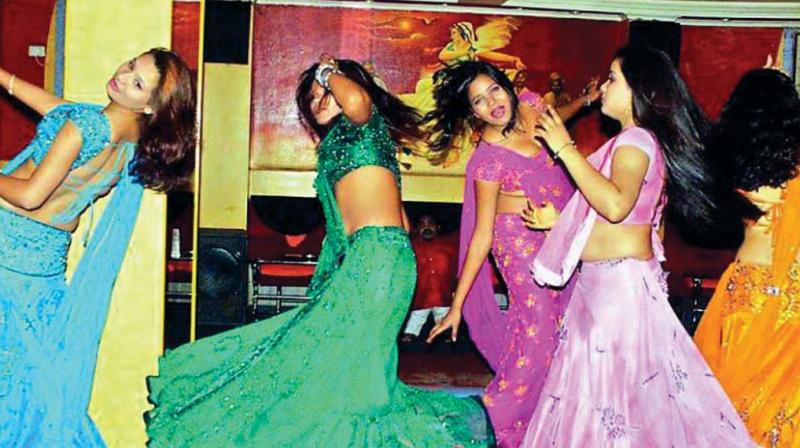Trafficked: Backstage with Bengaluru’s bar dancers

An estimated 5,000 children go missing in India every year, and as many as 50,000 women. Only about one-fifth of the missing children cases are solved, the remaining vanish. They are trafficked for a number of reasons: prostitution, beggary, bonded labour and even for medical reasons like organ harvesting. Bengaluru's 4000-odd bar dancers, lured with promises of good jobs then forced by agents into this profession, are among the victims of this rampant trafficking. And as their work is often mistaken for prostitution, their voices are rarely heard. On July 30, World Day Against Trafficking in Persons, through accounts by NGOs, activists and the girls themselves, ASHOKA M.K. unravels the sad, often dangerous lives of Bengaluru's bar dancers.
“I was brought to Bengaluru from Assam, lured by a prospective job. Unfortunately, I was made a bar girl and eventually, pushed into the flesh trade. I could not pull myself out as I had to support my family and I endured in silence, the pain of coming to this city. And though I earn well now, this is not what I wanted. The horrible memories of being a bar girl still haunts me.” These are the words of Rinku (name changed), a former bar girl, who says now, looking back, that, “The condition of bar girls is worse than that of prostitutes.” She reflects the conditions in which over 3000 bar girls who work in various dance bars in the Silicon City.
Lured with the promise of a good job in a metropolitan city, bar girls are transported from Northern and North-Eastern states. Once here, they are confined like animals. There are over 30 bands in the city, where bar girls are employed, with over 50 girls sometimes working at a single establishment. The total number of bar dancers in the city is estimated to be between 3000 and 4000. These establishments are located mainly in Indiranagar, Ashoknagar, Cubbon Park and Wilson Garden, although areas like Koramangala and Indiranagar also have some.
The girls are told this is a temporary arrangement, that they need to work for live bands or in dance bars for a short while, until they are shifted to other jobs. This assurance will never be fulfilled.
The girls are classified by their employers. A ‘good looking’ girl can reportedly fetch the agent between Rs 25,000 and Rs 30,000 from the bar owners. The girls themselves get fixed salaries. In many cases, these girls are either too afraid or too ashamed to tell their parents about their actual work. According to activist Chetana Theerthahalli, Indians still don’t understand the concept of a ‘bar girl’. The majority, she says, simply think of them as prostitutes. “We need some maturity as a society to understand that this is a profession for many girls,” she adds.
“I didn’t know much about dancing. I had been promised a job, then forcefully put in a dance bar,” says another bar girl. She describes herself as ‘average-looking’, but still found that “people showered her with jewellery and money. But all this money is taken by the middlemen,” she says, adding, “We are forced to live in bathroom-like rooms. After dancing, the middleman sends us to men who pay him. I get nothing. Another girl came from Siliguri but I don’t know what happened to her.”
Girls who are classified as ‘average looking’ fetch agents between Rs 5,000 to Rs 10,000. The good-looking ones can command upto Rs 50,000 at the time of purchase. When they are made to work in dance bars, they receive a monthly salary of Rs 25,000. Recently, after much struggle, these bar dancers have begun to get a share of the money and valuables that they are gifted, says a source.
World Day Against Trafficking: As the whole world condemns human trafficking in one voice on the occasion of World Day Against Trafficking in Persons, celebrated on July 30, society still does turn a blind eye towards the human trafficking that continues to thrive.
An estimated 5000 children go missing every year in India. The authorities manage to find about 1,000 kids, a fifth-of the total number. The remainder just vanish. As many as 50,000 women are estimated to be missing each year. Almost all, barring a few cases, will be victims of human trafficking.
“Human trafficking is done for a different purpose,” says retired police officer Lokeshwar. “It is done for prostitution, beggary, beggary, bonded labour and medical purposes, too. Among all these, medical reasons are the most cruel. Their body parts are taken and nobody knows what happens to them afterwards,” he says.
Father Mathew Thomas, Executive Director Don Bosco, who works in the field of rescue operations of trafficked and runaway children explains that, they rescue between 12 and 15 children everyday in Bengaluru.
NGOs like Don Bosco work alongside the police to keep a check on human trafficking. Their volunteers, who are present in places like bus stands and railway station, keep the vigil.
The police department in Bengaluru, which is taking the issue very seriously, has established Special Juvenile Police Units in every police station. A lady cop and a police officer of the rank of head constable will be in charge of the unit. Whenever, there is human trafficking and rescue, the victims will be handed over to Child Welfare Committee (CWC). CWC ensures that the victims reach home safe.

